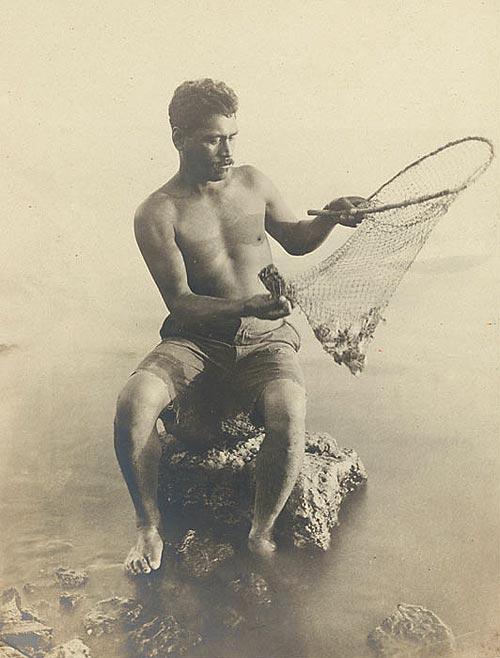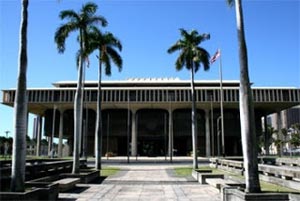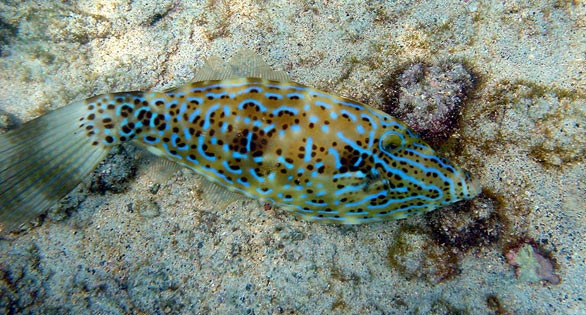
White-spotted Puffer, Arothron hispidus, nuzzles the photographer’s camera on a reef off the Big Island of Hawaii. Image: Brocken Ingaglory/GNU.
2013 Promises to be a potentially decisive year in the history of Hawaii’s marine ornamental fisheries
By Ret Talbot
A landslide of 13 legislative measures that could significantly impact the aquarium fishery in Hawaiian waters was introduced in the state legislature in the week between opening day on January 16th and the cutoff deadline for new bills on January 24th. At least three of the measures—two senate bills and one house bill—seek to close the fishery in state waters, while several others not explicitly seeking to end the commercial aquarium fishery would most likely do just that if passed.
Observers close to the situation say the upcoming legislative session is looking like a very difficult several months ahead for pro-aquarium fishery advocates. Several fishers told CORAL this will be the most difficult year yet for those defending the State’s most valuable inshore commercial fishery. A handful of measures seek to better regulate the fishery—rather than close it down—and are supported by state fishery managers as important steps toward further regulating the fishery and insuring long-term sustainability.
Last year—the second year in Hawaii’s two-year term of a Legislature that begins in an odd-numbered year and ends in an even-numbered year—a total of 18 aquarium fishery-related measures were introduced. Several of the proposed measures were carried over from the previous year, but all failed to progress to a hearing.
This year, while the number of measures is fewer, efforts to further regulate or ban the aquarium fishery appear to have gained traction, with one bill (SB26, see sidebar) already scheduled for a hearing. Many of the measures before the Legislature in 2013 are nearly identical to measures that failed to gain traction last year, but, as State House observers point out, the composition of the Legislature has shifted significantly.
“The Most Difficult Year Yet”
A number of the bills introduced over the past week are, in essence, carbon copies of bills that failed last year, but while many of the bills are familiar, many of the faces in both the Senate and the House are not. After a redistricting shake-up and the election of a new batch of freshmen legislators, as well as the elevation of some more veteran legislators to leadership positions, pro-aquarium fishery advocates in Hawaii tell CORAL that communicating their message regarding the sustainability and value of the fishery will be harder than ever.
“This is going to be a very difficult year—probably the most difficult we have faced,” says one fisher who spent opening day at the State House meeting with legislators. “We are going to need a lot of support and assistance in communicating our message.” Rene Umberger, one of the de facto leaders of anti-aquarium fishery efforts, was also on hand with Inga Gibson, Hawaii director of the Humane Society of the United States (HSUS) meeting with legislators. While Umberger downplays any changes in the legislature as being in her camp’s favor, the anti-aquarium movement has continued to communicate their message effectively and garner support in what has largely become an appeal to ethics as opposed to a discussion about fishery sustainability and the available, peer-reviewed data.
The Ban Bills
Senate Bill (SB) 374, SB677 and House Bill (HB) 108 all seek to end the commercial aquarium fishery in state waters. SB374, introduced by freshman Senator Russell Ruderman, would ban the sale of aquatic life for aquarium purposes statewide, while SB677, introduced by Senator Will Espero, would prohibit the taking of aquarium fish for commercial sale.
HB108 is the house version of SB374 and was introduced by Representative Faye Hanohano at the request of another party. Senators Gabbard and Espero, who are involved with introducing six and four aquarium fishery-related measures respectively and who each chair a committee in which aquarium bills may be heard, will likely play significant roles in shaping the legislative debate over the aquarium fishery in the coming weeks. Ruderman, whose name is on four of the bills and who is the vice chair of one committee, will also likely play an important role in shaping the debate.
SB27, introduced by Gabbard and Ruderman, would explicitly prohibit the sale and use of synthetic nets for gill net fishing, but there is some concern by fishers that it could eliminate the use of barrier nets commonly employed by aquarium fishers. If aquarium barrier nets became prohibited under the law, the result would probably not be the end of the fishery, but it would certainly change it dramatically. For example, a fish like the Yellow Tang, Zebrasoma flavescens, which is commonly caught in significant numbers in barrier or fence nets, would likely increase spectacularly in value if all Yellow Tang had to be collected with hand nets. This would severely alter the West Hawaii fishery, the State’s largest aquarium fishery by far, which depends on collecting significant volume of a limited number of highly desirable species. The Oahu fishery, on the other hand, would not be as affected by a ban on barrier nets, as the Oahu fishery is far more focused on lower volume, high dollar species.
The Regulate to Ban Bills
Like last year, there are several measures not seeking to explicitly close the aquarium fishery but, if passed, would essentially do just that. SB931, introduced by Senator Gilbert Kahele and a near carbon copy of last year’s SB2002, would delegate regulation of aquarium fishes found in waters within a three-mile limit of each island to the respective counties. SB676, introduced by Espero and similar to last year’s SB2408, which he also authored and introduced last year, would prohibit the taking of aquarium fishes six months out of the year. Neither of these bills would close the fishery outright, but some individuals close to the industry in Hawaii believe both bills, if passed, would eventually end the State’s marine aquarium fishery.

Hawaiian fisher inspecting his catch in a small net, 1925, from Historic Photographs of Old Hawai`i. The Islands’ fishing traditions stretch back to antiquity.
In the case of both so-called “Regulate to Ban” bills, there is, as there was last year, real concern the science is being sidelined. When it comes to SB931, several of the counties have a track record of voting on data-centered fishery management issues without seeking the most current data, consulting with state fisheries managers, and, in at least one case in Hawaii County, directly ignoring data presented. Given this track record, fisheries veterans believe that giving the counties the responsibility of regulating a fishery is not prudent.
Further, the counties, which are already feeling very real financial pressure, would be required to create a carbon copy of the fisheries management infrastructure that already exists at the state level. Finally, county control of the aquarium fishery would mean regulation would be based on use—a fish harvested for the recreational or commercial food fishery would be managed by the State, while a fish harvested for the marine aquarium trade would be managed by the County. It is difficult to envision how this would be in the best interest of the resource, which benefits most from a comprehensive management plan.
In the case of SB676, which would close the aquarium fishery for the months of January, February, March, July, August, and September, there are real questions about if such closures are based on data and would actually benefit the resource and create the intended results of stock recovery. It should be noted that many of the species commonly targeted have shown to benefit from Fishery Replenishment Areas (FRAs) in the West Hawaii Regional Fishery Management Area and don’t require further action to maintain stock. Further, closing the fishery for half the year would likely make commercial aquarium collection in the State non-viable for many fulltime aquarium fishers.
A Better Regulated Fishery?
The remainder of the newly introduced bills seek to better regulate the fishery. SB26, also introduced by Gabbard, would require population surveys for all indigenous species targeted in the marine aquarium fishery. This bill is particularly important at present, as it is the first bill for which a hearing has been scheduled (see sidebar). While this may work for the West Hawaii Regional Fishery Management Area (WHRFMA), where a 40-species White List of species approved for collection is awaiting final approval by the Board of Land and Natural Resources (BLNR), SB26 would likely end the Oahu aquarium fishery, at least in the short term.
The Oahu fishery has historically been far less contentious than the West Hawaii fishery, and little work has been done to establish population data. “The main reason they have the data [in West Hawaii],” one Oahu fisher tells CORAL, “is because there is so much debate over it, so it’s almost like they would be getting rewarded for the controversy.” Oahu aquarium fishers have historically been more proactive in working with fisheries managers to insure appropriate regulation and long-term sustainability for the Island’s aquarium fishery.
People familiar with the Oahu aquarium fishery also point out that, while the State does not have population data for the Oahu fishery on the level of what is available for the West Hawaii fishery, there is good catch per unit effort (CPUE) data showing the Oahu aquarium fishery to be stable. “Further,” one Oahu fisher points out, “the type of data requested by SB26 is beyond what is usually required to determine the health of a fishery, and there is nothing that would indicate that we should be shut down pending the availability of such data.” It is worth also mentioning that if SB26 passed, it is unknown whether or not the State would possess the resources to do fish surveys to the extent required by the bill. As already mentioned, it would therefore likely mean the end of Oahu’s aquarium fishery. If, at some point in the future, funding dries up for the West Hawaii surveys, it is also likely the West Hawaii fishery would close. As such, some people are looking at SB26 as a “regulate to ban” effort.
SB 378, also introduced by Ruderman, would authorize administrative inspections within the WHRFMA and require the Department of Land and Natural Resources (DLNR) to create an administrative scheme to monitor compliance with aquatic resources management regulation. This bill is similar to last year’s HB2067. In Hawaii, it is currently illegal for enforcement officials to inspect a fisher’s catch without probable cause, and while some believe there are constitutional issues with allowing inspection without probable cause, fisheries managers generally think more power when it comes to inspections would be a positive step for the fishery. HB359, introduced in the House by Representatives Nicole Lowen, Cindy Evans and Chris Lee is the house version of SB378. While there were concerns expressed by some fishers about a similar bill last year, a number of fishers, as well as some pro-aquarium fishery advocacy groups like the Marine Aquarium Societies of North America (MASNA) and the Pet Industry Joint Advisory Council (PIJAC), expressed support for giving more enforcement power to DLNR.
SB673, also introduced by Espero, would require and appropriate funds for DLNR to conduct an environmental assessment to determine whether aquarium fish permits should continue to be issued.
HB 989, introduced in the House by Evans and Hanohano, would increase penalties for unlawful taking of non-game fish or any specimen of aquatic life. HB989 is essentially the same measure as last year’s HB2125. While not garnering unanimous support, HB 989 is generally seen as a bill that would be good for the fishery both in terms of the actual resource and in terms of perceptions about how the resource is being managed.
Finally HB185, introduced by Representatives Evans, Mele Carroll, Nicole Lowen, and Angus McKelvey, is essentially the same as HB2129 introduced last year and strongly supported by fishery managers, as well as some fishers and aquarium fishery advocates. Those in favor of this bill argue it would lead to a better-managed fishery, as it gives fisheries managers the ability to manage the fishery in real time implementing, for example, bag limits and closures when the data warrants such measures without having to go through the cumbersome and timely administrative rule-making process. Other aquarium fishers, however, criticize the bill saying it is too broad and that provisions are already in place for emergency regulation. There is also serious debate about a provision in the bill requiring DLNR to establish a limited entry program for aquarium fishers. Limited entry would cap the number of fishers able to fish the resource and may, according to some, force a few current fishers out of the fishery. Fishery managers maintain that all fishers currently fishing legally within the aquarium fishery would be allowed to continue fishing even if a limited entry fishery is established.
Not All Changes Favor Anti-Aquarium Advocates
Given the changing face of the Hawaii State Legislature, the continued momentum of anti-aquarium fishery initiatives and early indications that legislators may be more willing to take up aquarium-related bills this year, it is likely that 2013 will be a challenging year for Hawaii’s aquarium fishery.
Not all the changes, however, favor anti-aquarium fishery advocates. This year aquarists are as engaged, informed and interested in advocating for Hawaii’s marine aquarium fishery as ever before. PIJAC has expressed a commitment to advocating aggressively on behalf of the State’s aquarium fishery, and groups like MASNA, as well as some aquarium media outlets like CORAL Magazine and Advanced Aquarist, have vowed to do what they can to support a truly sustainable and well-managed aquarium fishery in Hawaii. With the first hearing scheduled for Tuesday, January 29, there will be plenty of opportunities for those in support of a sustainable marine aquarium fishery in Hawaii to be heard.
TO GET INVOLVED
The first bill to be scheduled for a hearing is SB26.
Interested parties can submit testimony through the State Legislature Website at http://www.capitol.hawaii.gov/submittestimony.aspx
Type “SB26” in the box, and follow the instructions. You can upload a document file, or just put your comments in the “additional comments” field.
The full bill can be read here: http://www.capitol.hawaii.gov/measure_indiv.aspx?billtype=SB&billnumber=26&year=2013
Interested parties may also write or call the committee members, but it is important to understand that emails directly to legislators will not count as testimony (although they can be quite helpful).
SB26 has been jointly referred to the Committee on Water and Land (WTL) chaired by Senator Malama Solomon and vice-chaired by Senator Maile Shimabukuro AND the Committee on Energy and Environment (ENE) chaired by Senator Mike Gabbord and vice-chaired by Senator Russell Ruderman.
The introducers of the bill are Senators Gabbard, Chun Oakland and Ruderman. WTL committee members are: Senators Dela Cruz, Ihara, Ruderman, Thielen, and Slom. ENE committee members are: Chun Oakland, Ihara, Slom.
WTL Committee Website (with contact information): http://www.capitol.hawaii.gov/committeepage.aspx?comm=WTL
ENE Committee Website (with contact information): http://www.capitol.hawaii.gov/committeepage.aspx?comm=ENE







Turf War in Hawai’i
http://www.saia-online.eu/images/stories/uploads/Hawaiian%20Turf%20War%20with%20Chrono.pdf
It seems to me that the trade needs to be more aggressive in finding solutions to the issues raised not just defending the viability of the data and systems presently available. There is no technical reason, for example, that each of the different fishery areas cannot have a tac for all species harvested by the trade. There are a couple of systems out there within the trade that could produce a candidate for trialing a tac setting program. The primary limitation would be cost. Sufficient funding should be able to be found to support something as important as this. Funding from the trade itself, donors and Gov’t. However with the ending of MAC, and the limitations of both MASNA and PIJAC to tackle supply side issues, a new vehicle is needed to drive forward a solutions oriented approach to the problems facing the trade. The trade has the solutions to most of the issues facing the supply side of the industry within the different parts of the trade already. With better organization and clarity of vision, we can defend and grow our trade which is, afterall, potentially the single most important coral reef conservation tool in the world.
Good to see more protection on fish species for the aquarium trade.Coral export to the USA SHOULD BE STOPPED .They should adopt same as South Africa a total ban on coral in or out of South Africa.This is for future generations and not only money making.I have a reef Aquarium as well.More auqa culture should be encouraged to sustain wild stocks.
Shantha, in response to your comment about South Africa, coral harvest from Hawaii’s water isn’t legal and hasn’t been for some time. The same can be said from Florida’s waters; stony coral harvest isn’t allowed (Acropora cervicornus and A. palmata are both endangered species as well). You might be interested in the Coral Restoration Foundation’s efforts where aquarium mariculture techniques are being used to grow coral for reef restoration in the Florida Keys.
Admittedly, I’m confused by your comment that US coral imports should be stopped but that aquaculture should be encouraged to sustain wild stocks – aquaculture / mariculture won’t happen if no one is able to buy the product. I think your point meant to suggest that the wild harvest of coral for export to the US should end? Such a clarified position would make more sense given the context of your post.